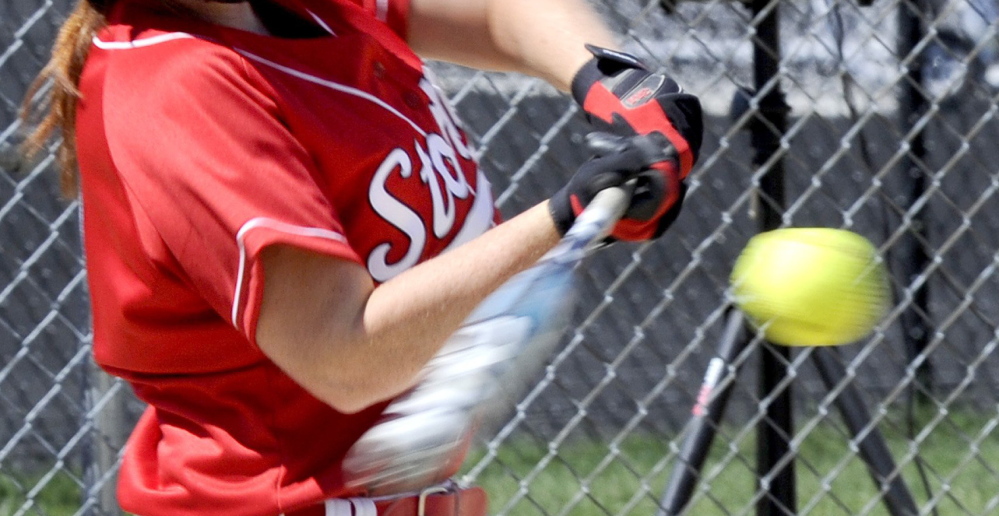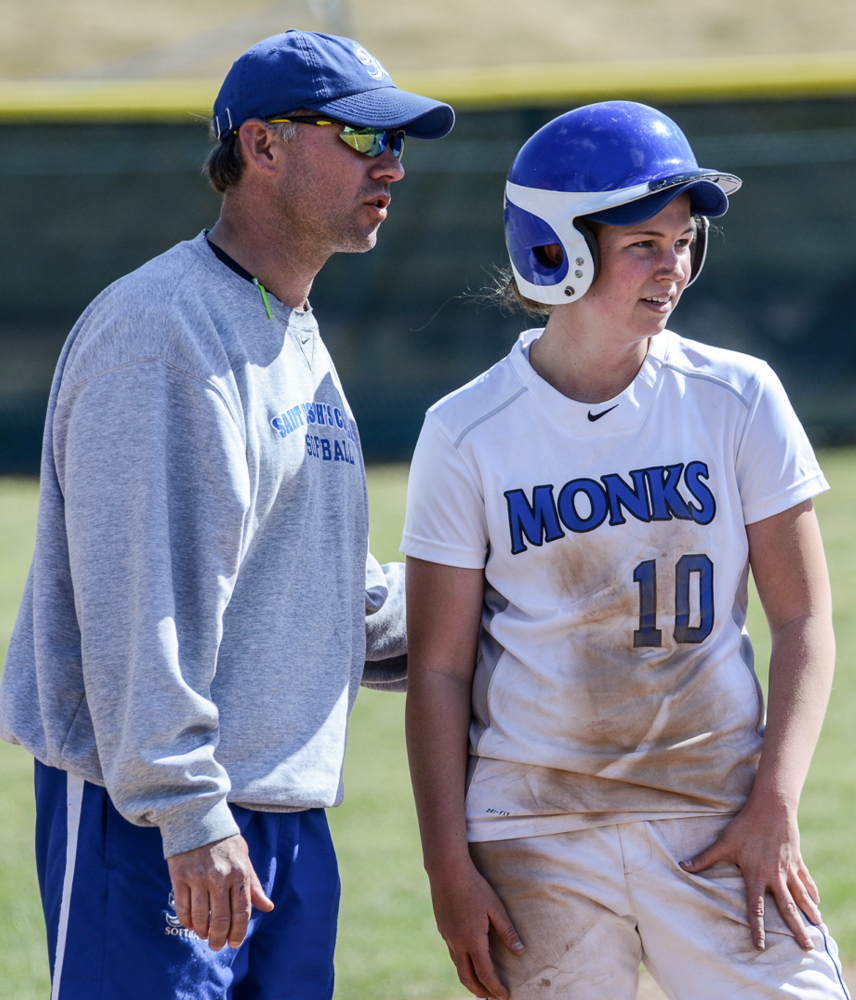Sarah Jamo, the softball coach at the University of Southern Maine, was at a clinic over the winter when a high school coach asked her about coaching outfielders.
“The outfield is fun now,” Jamo responded, “with all the balls going out there.”
High school softball in Maine has changed significantly in the five seasons since a rule change moved the pitching distance from 40 feet to 43.
Before then, softball was dominated by pitching. It was not uncommon for pitchers to record 15 strikeouts per game, and the best of them gave up fewer than 12 hits in a season.
Now hits and scoring are up, strikeouts are down and no-hitters are back to being special performances.
“I think it’s been a real positive change for the game,” said Ralph Aceto, the South Portland High coach. “It makes all the players better. Before, at 40 feet, if you had a dominant pitcher, you could pretty much go out there with a pitcher and a catcher and not play the rest of the field. Now you have to play defense.
“I think more kids are gaining confidence now.”
That confidence seems to be translating to better players. More Maine high schoolers appear to be getting a chance to play college softball.
Maine adopted the change for the 2010 season, one year before the National Federation of State High School Associations mandated it for all states.
Several states before Maine already had moved the pitching rubber back to 43 feet, including Florida, Oregon and Massachusetts, and noted an increase in offense and heavier reliance on defense.
The national federation made the rule change with the intent to balance out the game. Pitchers, especially the hard-throwing ones who could hit 60 mph, dominated from 40 feet. But the extra three feet gives batters a little more time to react. While the exceptional pitchers will still dominate from any distance by moving the ball around – “Those extra three feet don’t mean anything to the elite pitchers,” said Jamie Smyth, the coach at St. Joseph’s College in Standish – hitters put the bat on the ball more often now.
“It’s become a little bit more of a team sport,” said Jamo. “You need everyone. You can’t hide someone in right field anymore.”
Tom Griffin, the veteran coach from powerhouse Scarborough High, keeps close track of statistics. According to numbers he provided from the 2009 season (the last at 40 feet) and 2013 (the last full season of stats available from 43 feet), hitters are catching up with the pitchers.
Scarborough’s pitchers, always among the best in the state, gave up 0.8 walks per game in 2009 but 3.5 in 2013. They struck out 12.1 batters per game in 2009, only 7.4 in 2013. The opposing team put 18.9 balls into play in 2009, a number that jumped to 25.8 in 2013.
“It certainly has put more offense into the game,” said Griffin. “I think it’s a combination of (the change to 43 feet) and more kids putting an emphasis into hitting instruction in the winter. We’re definitely not seeing the dominant performances we saw in the past.”
Coaches and players alike believe it has made for a better game at the high school level.
Audrey Grinnell of Saco attended Cheverus High and went on to play at the University of Connecticut, a Division I program. Grinnel, who finished her UConn career this spring, is now coaching the Maine Thunder U-18 team out of The Edge Academy in Portland. Her team is recognized as one of the best in the region and she sees more college coaches scouting her players.
“It’s exciting to see the sport grow and the girls get noticed,” she said.
It’s still unusual for a Maine high schooler to land on a Division I program. There are 335 D-I programs in the nation, each with the equivalent of 12 scholarships. There are 269 Division II programs, each with the equivalent of 7.2 scholarships.
Along with Grinnell, eight Mainers were on D-I rosters this spring. Five played at the University of Maine: Hannah Hill of Fryeburg, Shelby Obert of Skowhegan, Alexis Bogdanovich of South Portland, Erin Bogdanovich of South Portland and Chloe Douglass of Orono. The others were Sam Bedore of Bangor (Rhode Island), Janelle Bouchard of Kennebunk (Valparaiso) and Whitney Jones of Skowhegan (Seton Hall).
Six other Mainers played on D-II teams in New England this spring, also earning scholarships. The rosters of Maine’s nine Division III programs, which do not offer athletic scholarships, are filled with Mainers.
Scarborough senior Alyssa Williamson has earned a scholarship to play at D-I Drexel in Philadelphia. Her teammate, Megan Murrell, will play at D-II St. Anselm in Manchester, New Hampshire. And Thornton Academy’s Erin Brayden will play at Stonehill College, another D-II program, in Easton, Massachusetts.
Michelle DiGregorio, the coach at D-II Bentley University in Waltham, Massachusetts, had two Mainers on her roster this spring: Kennebunk’s Carinn Burns, a walk-on, and Biddeford’s Katelyn Lebreux, on scholarship.
“As they have made changes that have gone along with the college game, I think you’ll see more Maine players playing at Division II,” DiGregorio said.
Both DiGregorio and Stonehill Coach Jill Gagnon, who recruited Murrell and had Tayla Trask of Lincoln (and Mattanawcook Academy) on her roster this year, said Maine’s weather and short season hinder a player’s development. But they see better players coming out of Maine now that the high school rules are more uniform with the college rules.
“I know there are some good kids up there,” Gagnon said.
Smyth, the St. Joseph’s coach, said the rule change has made recruiting a little easier.
“As a college coach, it gives you a better barometer for what the pitchers have for pitches,” he said. “Sometimes, say six years ago, you’d scout a player and find yourself wondering how that would translate to 43 feet.”
And, he added, you can get a feel for fielders.
“You can now actually get a better sense of whether a kid can defend it at the college level,” Smyth said. “When you go to a game and the pitcher strikes out 15 batters and you’re trying to scout the shortstop, how do you know if she can field the ball? You now get a better cross-section of what they can do.”
Lynn Coutts, the UMaine coach, is reluctant to say the game has changed strictly because of the rule change. She, like Griffin, notes that more teams and more players are practicing their hitting.
“I think it has helped,” Coutts said. “But again, it all depends on what type of pitching you’re seeing. In high schools in Maine, how many pitchers can throw in the 60s? Not many.
“It is more work to pitch from 43 feet. Pitchers have to put in more time. You can’t miss as much, so walks and hits are up.”
You have to make the ball move more from 43 feet, make it rise, curve or sink. Jamo, the USM coach, found that out when she made the jump from Greely High (where she pitched at 40 feet) to UMaine, at 43 feet.
“It was an adjustment,” she said. “In high school I was more of a thrower. I had decent mechanics and I just threw as hard as I could (which was in the low 60s). In college, especially making the jump to Division I, I had to learn how to pitch; it was back to the drawing table for me.
“I had to learn how to throw pitches, how to make the ball move, rather than just throw it as hard as I could.”
Jamo’s 18-player roster at USM this spring had 15 Maine players. Ten Mainers were on the 18-player roster at St. Joseph’s, which made the D-III NCAA tournament this spring.
“I want to build our program around Maine kids,” said Jamo. “They definitely have the talent. It’s just a matter of going out there and finding it.”
Mike Lowe can be reached at 791-6422 or at:
mlowe@pressherald.com
Twitter: MikeLowePPH
Copy the Story LinkSend questions/comments to the editors.





Success. Please wait for the page to reload. If the page does not reload within 5 seconds, please refresh the page.
Enter your email and password to access comments.
Hi, to comment on stories you must . This profile is in addition to your subscription and website login.
Already have a commenting profile? .
Invalid username/password.
Please check your email to confirm and complete your registration.
Only subscribers are eligible to post comments. Please subscribe or login first for digital access. Here’s why.
Use the form below to reset your password. When you've submitted your account email, we will send an email with a reset code.